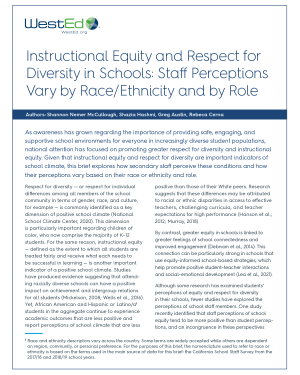Instructional Equity and Respect for Diversity in Schools: Staff Perceptions Vary by Race/Ethnicity and by Role
Description
As student populations become increasingly diverse, more schools are recognizing the importance of providing safe, engaging, and supportive school environments. As a part of these efforts, national attention has focused on promoting instructional equity and respect for diversity. Given that instructional equity and respect for diversity are important indicators of school climate, this brief explores how secondary staff perceive these conditions and how their perceptions vary based on their race or ethnicity and role.
Key Findings
- On average, African American school staff perceived their school’s instructional equity less positively and had more negative perceptions of respect for diversity in their school settings, compared with colleagues from other races/ethnicities.
- Teachers, special education teachers, and administrators had the most positive perceptions of their school’s instructional equity, whereas paraprofessionals, school resource officers, and counselors and psychologists had the least positive perceptions of their school’s instructional equity.
- Teachers and administrators had the most positive perceptions of respect for diversity in their schools, whereas counselors and psychologists as well as police and school resource officers had lower average perceptions of respect for diversity.
Resource Details
Stay Connected
Subscribe to the E-Bulletin and receive regular updates on research, free resources, solutions, and job postings from WestEd.
Your download will be available after you subscribe, or choose no thanks.




